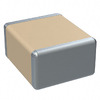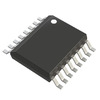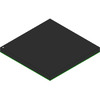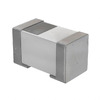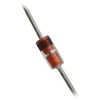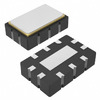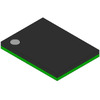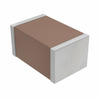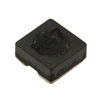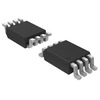Everything You Need to Know About the BC549 Transistor
The BC549 is a small, but widely used, NPN transistor that plays a key role in many low-power electronics projects. Whether you need to amplify weak signals or control small loads, the BC549 is a reliable choice. In this article, we’ll explore what makes the BC549 useful, where it can be applied, and how you can use it in your circuits. From basic switching tasks to audio amplifiers, this versatile component has many applications in everyday electronics.Catalog
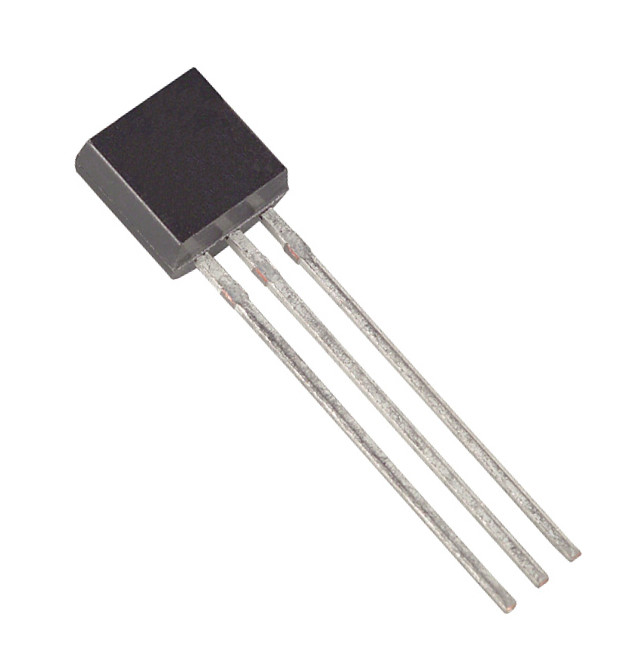
What is the BC549 Transistor?
The BC549 is an NPN transistor commonly used for general-purpose applications. It has three pins: emitter, base, and collector, and comes in a small, easy-to-use TO-92 package. It can handle up to 100mA of current, making it ideal for low-power tasks like switching small loads or amplifying signals. The maximum voltage between the collector and emitter is 30V, so it's best suited for low-voltage circuits.
This transistor has a gain range between 420 and 800, which allows it to amplify weak signals effectively. When the base is given a small voltage, the transistor switches on and allows current to flow from the collector to the emitter. Being an NPN transistor, it uses electrons as the main charge carriers, which move faster compared to holes in PNP transistors, making it more efficient for many tasks.
BC549 Pinout Diagram
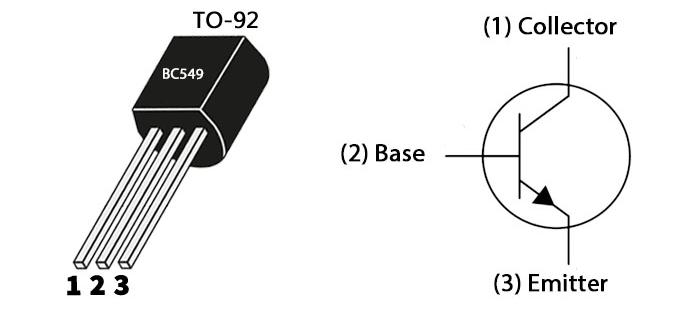
BC549 CAD Model Details
Symbol

Footprint
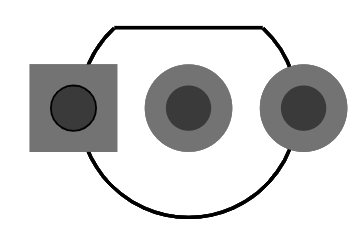
3D Model
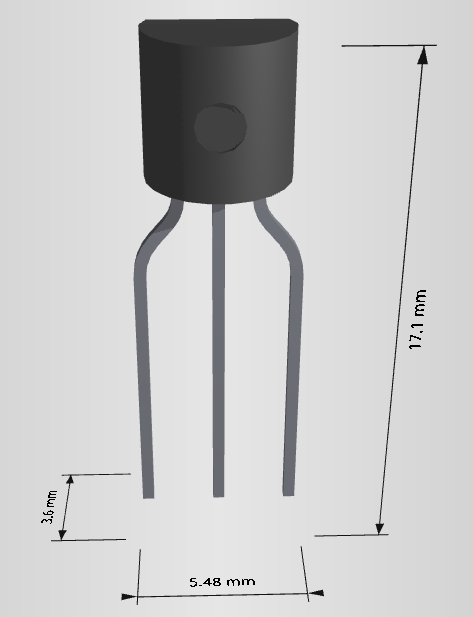
BC549 Transistor Features
The BC549 is a widely used NPN general-purpose transistor due to its versatile features, making it suitable for a variety of low-power applications. Below are the detailed features of the BC549 transistor:
Type of Package: TO-92
The BC549 is available in a TO-92 package, a plastic-encased, compact, and low-cost package that is suitable for through-hole mounting. This package offers excellent mechanical stability and electrical insulation, making it a popular choice for many general-purpose low-power applications. It is also available in the SOT54 package, offering surface-mount technology (SMT) for more compact designs.
Type of Transistor: NPN
The BC549 is an NPN transistor, meaning it conducts current when a small positive voltage is applied to its base relative to its emitter. NPN transistors are more commonly used in applications compared to PNP transistors because they offer faster switching and higher current handling due to the faster movement of electrons compared to holes.
Maximum Collector Current (IC): 100mA
The transistor can handle a maximum current of 100mA through the collector pin. This makes it suitable for low-current switching applications such as driving small relays, LEDs, or other low-power loads. It’s important to ensure that the load does not exceed this current limit to avoid damaging the transistor.
Max Collector & Emitter Voltage (VCE): 30V
The maximum voltage between the collector and emitter terminals is 30V, which defines the highest voltage the transistor can withstand between these terminals when in the off state. This limits the BC549’s use to low-voltage applications.
Maximum Collector-Base Voltage (VCB): 30V
The maximum voltage between the collector and base terminals is also 30V. This parameter is essential when the transistor is reverse-biased, as exceeding this limit could cause breakdown and failure of the transistor.
Max Emitter-Base Voltage (VEBO): 5V
The maximum voltage between the emitter and base is 5V. This voltage rating is crucial to avoid damaging the transistor by exceeding the maximum allowable reverse voltage between these two terminals.
Maximum Collector Dissipation (Pc): 500mW
The BC549 has a maximum power dissipation of 500mW. This means the transistor can safely dissipate up to 500mW of power as heat before it risks thermal damage. Adequate heat sinking or thermal management should be ensured in designs where the transistor is expected to operate near this limit.
Maximum Transition Frequency (fT): 150 MHz
The transition frequency is the frequency at which the transistor's current gain drops to 1. With a transition frequency of 150 MHz, the BC549 is suitable for high-speed switching and small-signal amplification applications, particularly in audio and RF circuits.
Noise Figure: 1.2 dB
The BC549 offers a low noise figure of 1.2 dB, making it an excellent choice for low-noise applications like audio amplifiers, microphone preamplifiers, and other audio frequency circuits where noise performance is critical.
Minimum & Max DC Current Gain (hFE): 110 to 800
The transistor provides a wide range of current gain (hFE) from 110 to 800, depending on the operating conditions. This range of current gain makes the BC549 ideal for applications where signal amplification is required, such as audio amplification or sensor signal conditioning.
Maximum Storage and Operating Temperature: -65 to +150°C
The BC549 has a wide operating temperature range, from -65°C to +150°C, making it suitable for use in a variety of environmental conditions. However, care must be taken to ensure the transistor does not exceed this temperature range, as it could result in permanent damage.
BC549 Transistor Specifications
ON Semiconductor BC549 technical specifications, attributes, parameters, and parts with similar specifications to ON Semiconductor BC549.
| Type | Parameter |
| Mount | Through Hole |
| Mounting Type | Through Hole |
| Package / Case | TO-226-3, TO-92-3 (TO-226AA) |
| Number of Pins | 3 |
| Supplier Device Package | TO-92-3 |
| Weight | 4.535924g |
| Collector-Emitter Breakdown Voltage | 30V |
| Current - Collector (IC) (Max) | 100mA |
| Number of Elements | 1 |
| hFE Min | 110 |
| Operating Temperature | 150°C TJ |
| Packaging | Bulk |
| Part Status | Obsolete |
| Moisture Sensitivity Level (MSL) | 1 (Unlimited) |
| Max Operating Temperature | 150°C |
| Min Operating Temperature | -65°C |
| Voltage - Rated DC | 30V |
| Max Power Dissipation | 500mW |
| Current Rating | 100mA |
| Frequency | 300MHz |
| Base Part Number | BC549 |
| Polarity | NPN |
| Element Configuration | Single |
| Power Dissipation | 500mW |
| Power - Max | 500mW |
| Gain Bandwidth Product | 300MHz |
| Transistor Type | NPN |
| Collector-Emitter Voltage (VCEO) | 30V |
| Max Collector Current | 100mA |
| DC Current Gain (hFE) (Min) @ IC, VCE | 110 @ 2mA 5V |
| Current - Collector Cutoff (Max) | 15nA ICBO |
| VCE Saturation (Max) @ IB, IC | 600mV @ 5mA, 100mA |
| Voltage - Collector Emitter Breakdown (Max) | 30V |
| Frequency - Transition | 300MHz |
| Collector Base Voltage (VCBO) | 30V |
| Emitter Base Voltage (VEBO) | 5V |
| Height | 6.35mm |
| Length | 6.35mm |
| Width | 6.35mm |
| REACH SVHC | No SVHC |
| RoHS Status | RoHS Compliant |
BC549 Transistor Alternatives
| Part Number | Description | Manufacturer |
| BC549CRLRP | 100mA, 30V, NPN, Si, SMALL SIGNAL TRANSISTOR, TO-92 | |
| BC549CRL1 | 100mA, 30V, NPN, Si, SMALL SIGNAL TRANSISTOR, TO-92 | |
| BC549CZL1 | Small Signal Bipolar Transistor, 0.1A I(C), 30V V(BR)CEO, 1-Element, NPN, Silicon, TO-92 | |
| BC549CRLRA | Small Signal Bipolar Transistor, 0.1A I(C), 30V V(BR)CEO, 1-Element, NPN, Silicon, TO-92 |
Where Can You Use the BC549 Transistor?
The BC549 is best used in low-current applications where the load doesn’t exceed 100mA. It’s commonly found in circuits where you need to switch or control smaller components like LEDs, small relays, or low-power sensors. Because its base trigger voltage is just 5V, it can be controlled easily by many microcontrollers and 5V logic circuits like those found in Arduino or Raspberry Pi projects.
Besides switching tasks, the BC549 works well in amplification circuits, especially when dealing with small signals. Its gain range (from 420 to 800) means it’s effective at boosting weak signals, making it a good choice for applications like audio amplifiers or sensor signal conditioning. However, if your project involves larger currents or higher voltages, the BC549 wouldn’t be suitable, and you would need to look for a more powerful transistor.
How to Use the BC549 Transistor in Your Projects
Using the BC549 in your project is fairly straightforward. In switching applications, you simply connect the load (like an LED or small relay) to the collector pin, apply a small control signal to the base pin, and the transistor will switch on and allow current to flow through the load. This allows you to control the load using a low-power signal, such as an output from a microcontroller.
For amplification, the BC549 can be used in circuits like audio preamplifiers or signal amplifiers. In these circuits, a small input signal (like an audio signal or a sensor output) is applied to the base, and the amplified signal is taken from the collector. Thanks to its high gain and low noise characteristics, the BC549 is a good fit for such applications, ensuring a clean and amplified output.
In many cases, you’ll use the BC549 in common configurations like the common-emitter amplifier, where the emitter is grounded, the base is connected to the input signal (often through a resistor), and the collector provides the amplified output.
Common Applications for the BC549 Transistor
Due to its low current, low voltage handling, and high gain characteristics, the BC549 transistor finds use in a wide range of general-purpose low-power applications, including signal amplification, switching, and noise filtering.
Darlington Pair
BC549 can be used in combination with another transistor to form a Darlington pair, which increases current gain. This configuration is beneficial in applications where very high current amplification is needed from a small input signal. This is often used in applications like sensor circuits, where low input currents need to control larger outputs.
Sensor Circuits
The BC549 can be used in sensor circuits, particularly in low-power applications. It acts as an interface between sensors and microcontrollers by amplifying weak signals from the sensor. These signals can then be processed or used to trigger other components.
Audio Noise Filters
Due to its low noise figure, the BC549 is used in circuits that require clean signal amplification, such as audio noise filters. It can help reduce background noise in audio systems and improve the clarity of signals in audio preamplifiers and filters.
Audio Amplification
The BC549’s high current gain and low noise make it ideal for use in audio amplifiers. It is often used in the first stage of an audio amplifier to amplify small input signals before further amplification in later stages. This helps improve the overall sound quality in consumer electronics, such as radios, speakers, and microphones.
Switching Small Loads
BC549 can be used to switch small loads in circuits, such as LEDs, small relays, and other low-current devices. When interfaced with microcontrollers or logic circuits, it can act as a switch, turning on or off small loads based on the control signal.
Linear Audio Amplifiers
The BC549 is often used in the design of linear audio amplifiers due to its high gain and low noise characteristics. It is commonly found in headphone amplifiers, preamplifiers, and speaker systems where precise, low-distortion audio amplification is needed.
Small Signal Amplifiers
With a wide range of current gain, the BC549 is frequently used in small signal amplification. This includes amplifying weak signals in radio receivers, wireless devices, and communication circuits. Its low power consumption also makes it ideal for battery-operated devices.
Audio Preamplification
The BC549 can be used in preamplifier circuits for audio systems, where it amplifies small signals from audio sources such as microphones or musical instruments before they are fed into power amplifiers. Its low noise figure makes it perfect for maintaining sound clarity in these circuits.
Microcontroller Output
The BC549 can be used to amplify or switch output signals from a microcontroller. Since microcontrollers typically have low current output pins, the BC549 can amplify these signals to control higher-current devices, such as small motors, relays, or LEDs.
LED Array Sequence Controller
The BC549 can be used in sequential LED lighting applications where small current LEDs are turned on or off in a particular sequence. The transistor acts as a switch for each LED in the array, controlled by a microcontroller or timer.
Oscillator and Comparator Circuits
The BC549 can be used in oscillator circuits for generating waveforms or in comparator circuits where it helps in comparing voltages and triggering subsequent actions. These circuits are common in timer applications, signal generators, and frequency modulations.
Variety of Audio-Related Applications
The BC549 transistor is widely used in various audio-related applications including equalizers, audio processing circuits, and tone control circuits. Its low noise and high gain properties make it a popular choice for enhancing audio quality.
Astable and Bistable Multivibrators
BC549 can be used in the design of astable and bistable multivibrator circuits, which are used to generate square waveforms, pulse generation, and clock signals. These circuits are often used in timing applications or as part of logic circuits.
Current Mirror Circuits
BC549 is frequently used in current mirror circuits, which are used in analog integrated circuits for current regulation. These circuits are essential in applications such as operational amplifiers, analog signal processing, and voltage regulation.
Impedance Buffering and Switching Applications
BC549 can act as a buffer to isolate different stages of an electronic circuit, preventing one stage from loading the previous one. This application is common in amplifiers and other circuits where impedance matching and signal integrity are crucial.
Low Noise Stages in Audio Frequency Equipment
The BC549 is often used in low noise stages of audio frequency equipment, such as amplifiers or preamplifiers, where maintaining signal clarity is important. Its low noise figure ensures that it contributes minimal distortion or interference to the signal.
By offering excellent performance in a variety of low-current, low-power applications, the BC549 remains a popular choice in both hobbyist and professional electronics projects. Its wide range of uses makes it a versatile component in many circuits.
BC549 Transistor Package

Who Manufactures the BC549 Transistor?
The BC549 is made by ON Semiconductor, a well-known company that focuses on energy-efficient solutions. They offer a wide range of components, including power management products, signal management devices, and custom designs for various industries. Their portfolio includes components used in automotive, consumer electronics, communications, industrial equipment, and medical devices, among others.
ON Semiconductor has a global reach, with manufacturing facilities and offices spread across North America, Europe, and Asia Pacific. They are known for their quality control and reliable supply chain, ensuring that their products meet high standards and are readily available for different markets.
Datasheet PDF
BC549C Datasheet:
About us
ALLELCO LIMITED
Read more
Quick inquiry
Please send an inquiry, we will respond immediately.
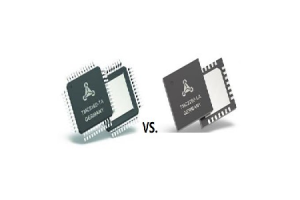
Breaking Down the Differences: TMC5160 vs. TMC2209 Stepper Drivers
on October 15th

Choosing Between CR2032 DL2032 CR2016 and CR2025 Batteries
on October 15th
Popular Posts
-

What is GND in the circuit?
on January 1th 2824
-

RJ-45 Connector Guide: RJ-45 Connector Color Codes, Wiring Schemes, R-J45 Applications, RJ-45 Datasheets
on January 1th 2399
-

Fiber Connector Types: SC Vs LC And LC Vs MTP
on January 1th 2009
-

Understanding Power Supply Voltages in Electronics VCC, VDD, VEE, VSS, and GND
on November 5th 1757
-

Comparison Between DB9 and RS232
on January 1th 1723
-

What Is An LR44 Battery?
Electricity, that ubiquitous force, quietly permeates every aspect of our daily lives, from trivial gadgets to life-threatening medical equipment, it plays a silent role. However, truly grasping this energy, especially how to store and efficiently output it, is no easy task. It is against this background that this article will focus on a type of coin cell battery that may seem insignificant on the...on January 1th 1674
-

Understanding the Fundamentals:Inductance Resistance, andCapacitance
In the intricate dance of electrical engineering, a trio of fundamental elements takes center stage: inductance, resistance, and capacitance. Each bears unique traits that dictate the dynamic rhythms of electronic circuits. Here, we embark on a journey to decipher the complexities of these components, to uncover their distinct roles and practical uses within the vast electrical orchestra. Inductan...on January 1th 1613
-

CR2430 Battery Comprehensive Guide: Specifications, Applications and Comparison to CR2032 Batteries
What is CR2430 battery ?Benefits of CR2430 BatteriesNormCR2430 Battery ApplicationsCR2430 EquivalentCR2430 VS CR2032Battery CR2430 SizeWhat to look for when buying the CR2430 and equivalentsData Sheet PDFFrequently Asked Questions Batteries are the heart of small electronic devices. Among the many types available, coin cells play a crucial role, commonly found in calculators, remote controls, and ...on January 1th 1489
-

CR2450 vs CR2032: Can The Battery Be Used Instead?
Lithium manganese batteries do have some similarities with other lithium batteries. High energy density and long service life are the characteristics they have in common. This kind of battery has won the trust and favor of many consumers because of its unique safety. Expensive tech gadgets? Small appliances in our homes? Look around and you'll see them everywhere. Among these many lithium-manganes...on January 1th 1469
-

What Is RF and Why Do We Use It?
Radio Frequency (RF) technology is a key part of modern wireless communication, enabling data transmission over long distances without physical connections. This article delves into the basics of RF, explaining how electromagnetic radiation (EMR) makes RF communication possible. We will explore the principles of EMR, the creation and control of RF signals, and their wide-ranging uses. The article ...on January 1th 1437









